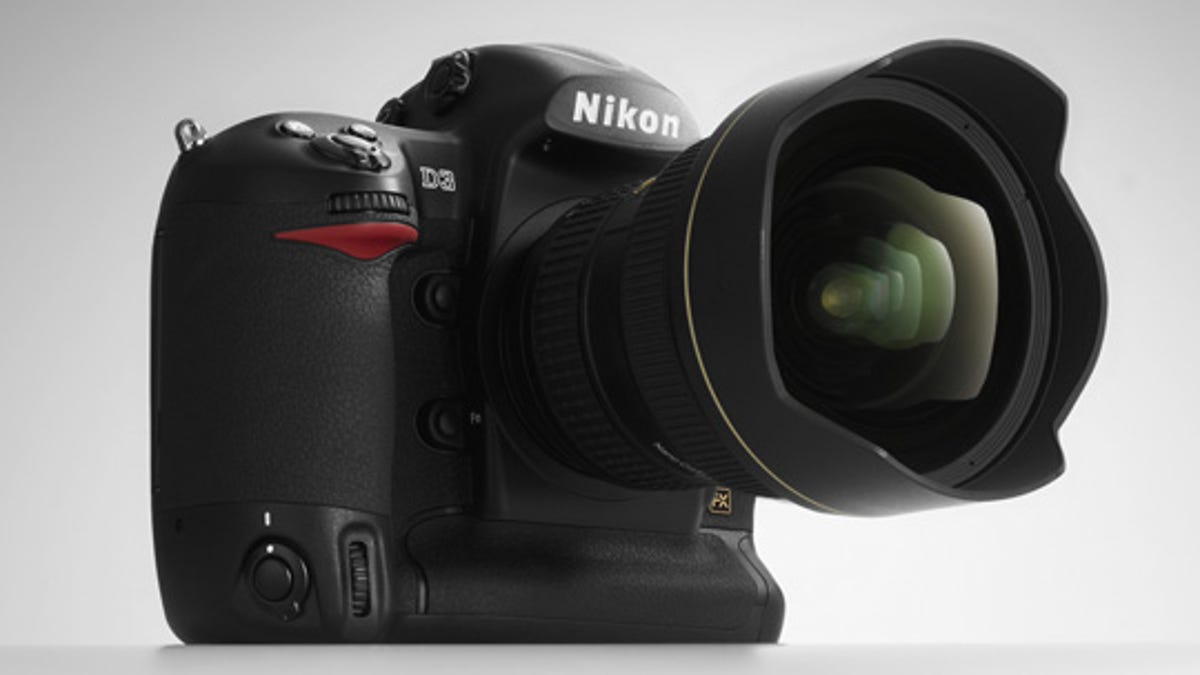Nikon goes full frame with D3
Nikon has announced its new full-frame 12.1MP D3, which is slated to hit stores this November for about $5,000.

The rumors have been fierce--and some of them have been true--yet now Nikon has made it official. Their new weather-sealed, top-of-the-line dSLR, the 12.2MP D3, will have a full frame CMOS image sensor, which Nikon has dubbed the FX format. Well...OK, it's almost a full-frame sensor. It measures 36mm by 23.9mm; just 0.1mm vertically shy (does that make it vertically challenged?) of the technical full-frame spec, but we'll let that slide. I know that any Nikon owners with DX lenses must be reeling right about now, so it pays to mention that the D3 will include a special DX mode that crops the sensor down to DX size, results in 5.1MP images, and can be set to engage automatically whenever you put a DX lens on the camera. Plus, as you might expect from the high-speed crop days of the D2Xs, the DX crop mode allows a slightly faster burst rate, which is said to let the D3 edge past the current dSLR speed king, Canon's 10fps EOS 1D Mark III. According to Nikon, the D3 will be able to shoot up to 11fps in DX crop mode, and up to 9fps in full-frame mode. In full-frame mode, and with a SanDisk Extreme IV UDMA CF card, Nikon says the D3 will be able to capture up to 64 large/normal JPEGs at its top burst rate, or up to 17 14-bit NEF (Nikon's RAW file format) or 20 12-bit NEF files.
Of course, the fun doesn't stop there. In its regular mode, the D3 offers sensitivity settings from ISO 200 to ISO 6,400, and if you turn them on, Hi-1 gives an equivalent of ISO 12,800 while Hi-2 offers an equivalent of an almost absurd ISO 25,600 (who needs light when you have CMOS sensors?), and Lo-1 can bring you down to ISO 100. Then there's the 51-point AF system, with 15 cross-type sensors and a 3D tracking mode that works in tandem with the 1,005-pixel metering system to help track your subject as it moves throughout the frame. This marks a new frontier for Nikon, in which the autofocus and metering systems work together in an attempt to achieve a new level of high-end performance. The metering system will also include a scene recognition system, that will be involved not only in determining exposure but also AF and white balance settings. Nikon says that the viewfinder covers nearly 100 percent of the frame and has a magnification of 0.7x. Other new features include a 3-inch, 920,000-dot (307,000-pixel) LCD screen, dual UDMA-compatible CF card slots that allow manual/automatic backup or tag-team use, 14-bit A/D conversion, 16-bit image processing, selectable 12- or 14-bit output, Nikon's new Expeed image processing, a carbon fiber/Kevlar shutter rated at up to 300,000 cycles (double the D2Xs's 150,000 cycles), and a full-sized HDMI high-definition output, so you can hook the camera up to a high-definition TV and enjoy your images after a long day of shooting.
But wait, there's more! In addition to all the goodies you're used to from the D2Xs, and the D-Lighting and Picture Control Systems that have been making their way into lower-end Nikon dSLRs, the D3 will include a virtual horizon line indicator. A graphic, displayed on the LCD, indicates how far off kilter the camera is--and when you line up the camera's horizontal line with the horizon line, the lines turn green to show that you are level. It's sure to be tons of fun on boats and airplanes.
Last, but not least, there's the D3's two Live View modes. The Hand Held mode uses a phase-detect AF system that doesn't need the mirror to be down to operate, while the Tripod mode uses a more standard contrast-detect AF system that brings the mirror down for a moment, only when you press the AF button on the body, then puts it back up so you can capture the shot. Using the LCD and the camera controls, you can select nearly any spot in the frame, set that camera to focus on it, and can even zoom in up to 10X to confirm focus. With the new WT4A 802.11a/b/g wireless transmitter, you can even operate the D3's Live View wirelessly from a computer. That means you'll be able to set the camera in a remote location and operate it from a laptop nearby. Combined with a long telephoto lens, this can become a paparazzi's dream camera.
The body design is very similar to its predecessor, as you can see from the image at the top of this post. For more detail on the body design, take a look at the slide show linked above. As if the dSLR market hasn't been exciting enough with Canon's recent announcements of its 1D Mark III, 1Ds Mark III, and 40D, the D3 and D300, along with Sony's, Panasonic's and Olympus' promised upcoming SLRs, will make this fall a veritable dSLR extravaganza. Nikon says that the D3 will hit stores this November for about $5,000. If you love the D2Xs, don't worry. Nikon says that the D2Xs will remain in the line for the forseeable future.
